The San Mateo Coast
For Needful Divers
Not so far from here, not so well known, there is a wild beautiful place of wind, sea mists
and deep golden red sunsets. Just go a bit west to the Cabrillo Hiway that
takes you along the coast from San Francisco to Santa Cruz.
This is a road trip instead of my usual dive trip. It is a road through land owned by nature and moistened by the clouds of the sea that collide with the tall mountains. It's a beautiful drive.
It is the worst diving in California. It was my playground.
The California Coast has a reputation for beautiful shorelines where forests meet the ocean at
cliff lined coves. Along the coast are redwood forests that have the tallest trees in
the world. Best known of these unspoiled shores is Big Sur that starts south of Monterey
and extends 120 steep twisting miles south to San Simeon. The remote North Coast is
well known to the rocky shore aficionado that seeks out the lonely tree lined coves and coastal
fields that display the harsh beauty where the cold ocean challenges the shore. Not so
many know of the rugged windy coast isolated by tall forested mountains from the nearby
Bay Area. Most travelers go by the shorter route inland rather than take Hiway 1 for
the long route from San Francisco to Santa Cruz. So mostly it is locals that get to
enjoy one of the wildest shorelines there is, the San Mateo Coast. And if you are
a way serious diver, you can do that there too.

San Francisco is a small architectural museum with some exceptional pieces.
A truely interesting city blessed by great natural beauty all around it.
This is where I was the first time I ever saw San Francisco. Every window
in the city seemed to be reflect the brilliant gold of the setting sun.
Might I suggest using the F11 key to expand what your browser will show.
Some of the pictures are pretty big.
This essay is to try to give a pleasant description of this beautiful place, particularly
to suggest it as somewhere to visit if you like such places. It's a short day trip if
you are near the Bay Area. From San Francisco to Santa Cruz is about 100 miles. It is
not a hard drive and mostly is not a winding road. Most of these pictures were shot last year on a trip down the coast with my friend Shawn. This is a gallery of image and word to show the beauty of the San Mateo Coast.
Usually I write diving guides, but this is probably more of a driving guide if
anything.
The diving is only worth it if you really want to dive and can't get to anywhere
else. The geology of the coast is mudstone and the visibility is usually between 6 feet
and blackout, generally closer to blackout. This is a harsh treacherous shore directly
exposed to every storm spawned on 5 oceans. The cold is dangerous. The currents are even
more dangerous than the big waves that can sneak up on you from 7000 miles away. This is
in the White Triangle between Ano Neuvo Island, The Farralon Islands and Bodega Bay.
Great White Sharks patrol their domain. It is rare, but accidents do happen.
There is good diving fairly nearby in
Monterey or North, so there is really little reason for anyone to dive here ... Unless
they are already here or maybe if they want a challenge. Like we say, it's all
good after diving there. I went to school in Santa Cruz and for me, this
was like Malibu had been during my high school years. It was close enough to
go diving in a couple hours, it was free and there was hunting. Oh yah, what more
do you need? I'll tell
you about the diving as I go along. Really though, if this book has a theme it is either
to take you there in word and image or maybe to inspire you to go there and see it for
yourself. It is such a place where you can see the sea in her unfiltered moods
and nature that is free of man.
I like to think that this is taking advantage of the potential of the web. Some of the
photographs are about 3 screens wide or so, but a web browser is perfect for showing pictures
like that. Almost no print media would let you do something like that. This was simply impossible not very long ago. ... It's a Coffee Table Book for the Web. If you don't
have time to read it
just look at the pictures and some of the captions. I did optimize the size on the pics the best
I could, but this is still a fairly large page. Obviously I'm writing this because I enjoy
writing. I hope you have the time to relax and enjoy it.
Now this isn't just about a road trip down the coast on a nice Spring day to take pictures
of pretty Spring flowers and the coast. Oh no. This is a
place where every cove and town holds as much personal baggage as I care to
dig out of the fragrant forest ground here. The warm breezes from the mountains blow across
my memory more strongly than they blow my hair.
Oh yah, have I got a history in these parts. Half Moon
Bay is not just a great place to go to the dock to enjoy a crab cocktail. It is also
where Dan and I rode our bikes to the first night we headed south from San Francisco to
Santa Cruz. Pigeon Point is not just a historic lighthouse challenging the sea. It is where
I parked my van on Friday nights to dive the endless rocky reefs the next morning.
Greyhound rock wasn't just a nice scenic vantage point above a cliff lined cove. It was a
deserted pristine playground where I found my lifelong challenge in the ocean. As you
descend into a small coastal valley, the chaotic traffic along the side of the road
doesn't signify an annoyance as people jockey to park or drive. No, that is the trail to
remote wide sandy beaches where rangers never venture and the people around the wind
whipped bonfires are as wild as the surf. Then again,
nearby is La Honda where Ken Kesey lived. Experiments were held on these beaches.
And Santa Cruz. Well now isn't it all about Santa Cruz? Perhaps the name means Holy Cross.
Perhaps it means Saint's Crossing, but you can only answer that if you are blessed enough
to live there. Maybe you aren't still there physically, but in moments of reflection you
always find yourself there again. It's like diving. Sometimes when you start you can
never stop. You can leave, but part of you will always remain.
So I hope you enjoy the pictures and I hope you enjoy the story... After that introduction
I really am curious about it myself. Hmmmm. Something odd. I must tell this trip as it was
photographed, from north to south. That's not how it was though. My center of gravity is
opposite that, always has been. I don't return to Santa Cruz. I always start there. It
will work out though.
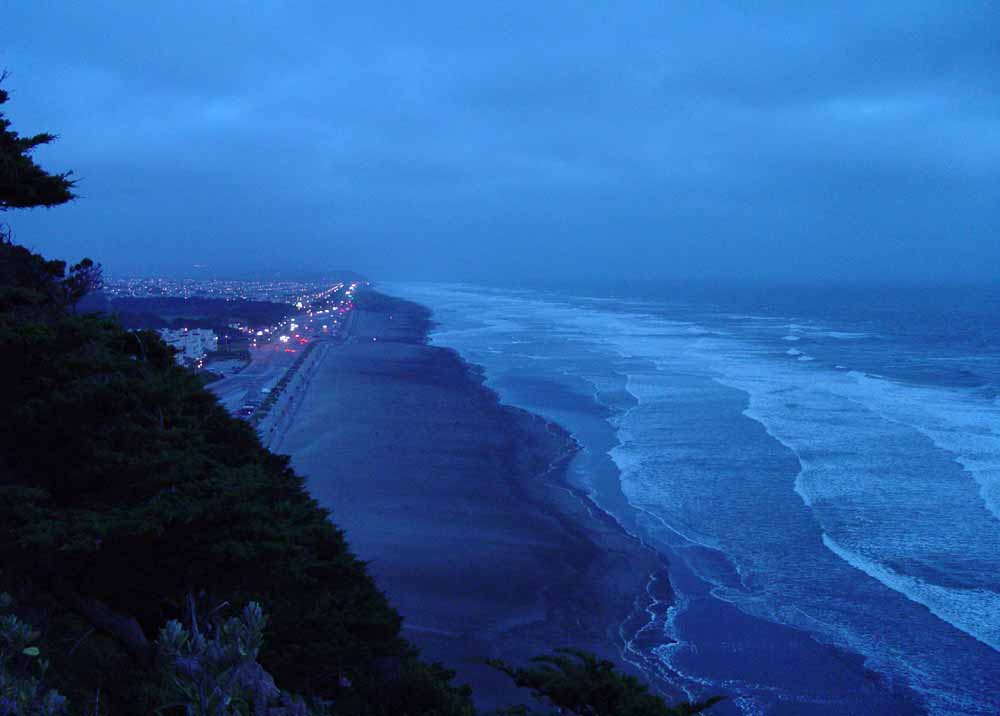
The evening marine layer comes over and softens everything. The lights on the Great Highway
take on a false brilliance in the dusk.
Looking south towards Pacifica and the start of the San Mateo Coast from Sutro Heights. San Francisco has some great history.
Say you are in San Francisco or anywhere in the Bay Area visiting for a few days... like
I was. I had flown up to spend the weekend with Shawn on the north side of
the bay in San Pablo. The plan was to make a long Saturday of it driving down the coast and
around Monterey Bay to Monterey and the Aquarium. Who knew what was past that?
After getting coffee at Peet's we crossed the Bay Bridge and entered San Francisco on a
beautiful clear morning. Our route took us across the city following the south side of
Golden Gate Park to Hiway 1.
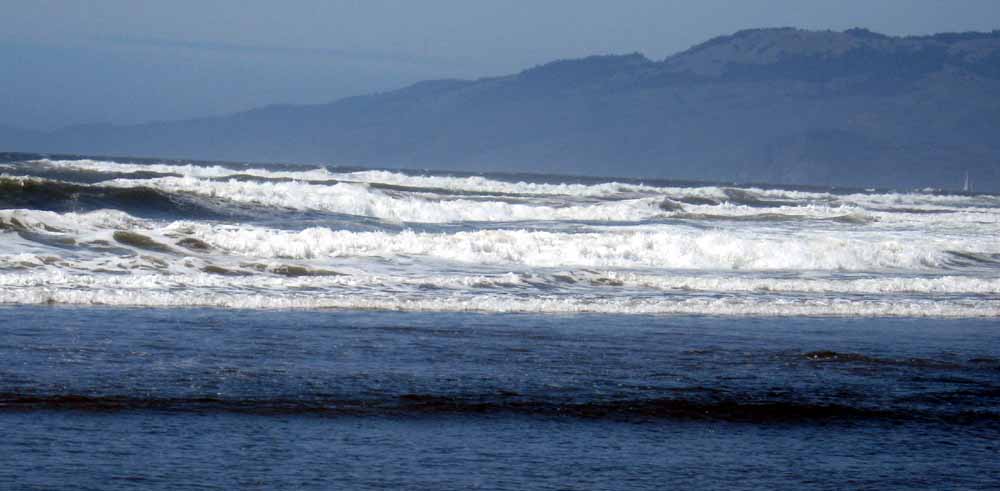
Looking at the Marin Headlands from North Beach.
As you go south from San Francisco, stay on the 1 as the 280 freeway heads off southeast
along the San Andreas fault that runs at the foot of the peninsula mountains.
It is easy to find. It's mostly flat coming away from the bay and then there is this
mountain range sticking up. There is San Andreas Lake that the fault was
named after. The 280 claims to be the only Scenic Freeway in the world and it may be
so. A lot of rain comes into the valley of the San Francisco Bay.
Instead of following those roads, stay to the right on Hiway 1 through Daley City and
towards Pacifica. The freeway loses lanes and the houses thin out. The shore comes in sight as
sandy coves with vast beaches and room for houses and stores. Then up a hill to climb over
a shattered rock mountain jutting into the sea. This is the folded landscape of the
fault. These mountains are what have preserved this coast. It is not a good commute.
The crispness of the salt air is awesome.
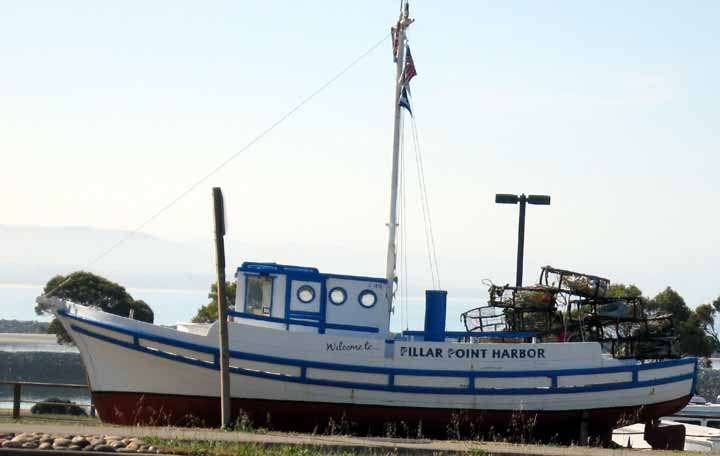
Old Crab Boat at Pillar Point Harbor

Pillar Point Panorama
This is looking past Pillar Point Harbor at Pillar Point. That giant golf ball looking thing replaced
what was an
unimaginably large radar dish, probably for intelligence satallites. On the other side of that
point is Maverick's, some of the biggest, coldest, gnarliest surf in the world. The docks are
interesting as are most working docks along the California Coast. There are party fishing boats.
Sometimes the fishing can be great though the rock fishing is depleted. At the dock market
you can buy local fish and crab fresh from the boats. I always look for a fish market there
and woof down a couple crab cocktails, maybe some smoked fish. One way or another I always
eat well. Salmon are caught off here parts of the year. Fishermen also catch Striped Bass
all along here or at least to San Francisco. I've heard of them speared off of Pacifica.
It is a great tasting fish and
one of the best fighters I have ever tangled with on a line.
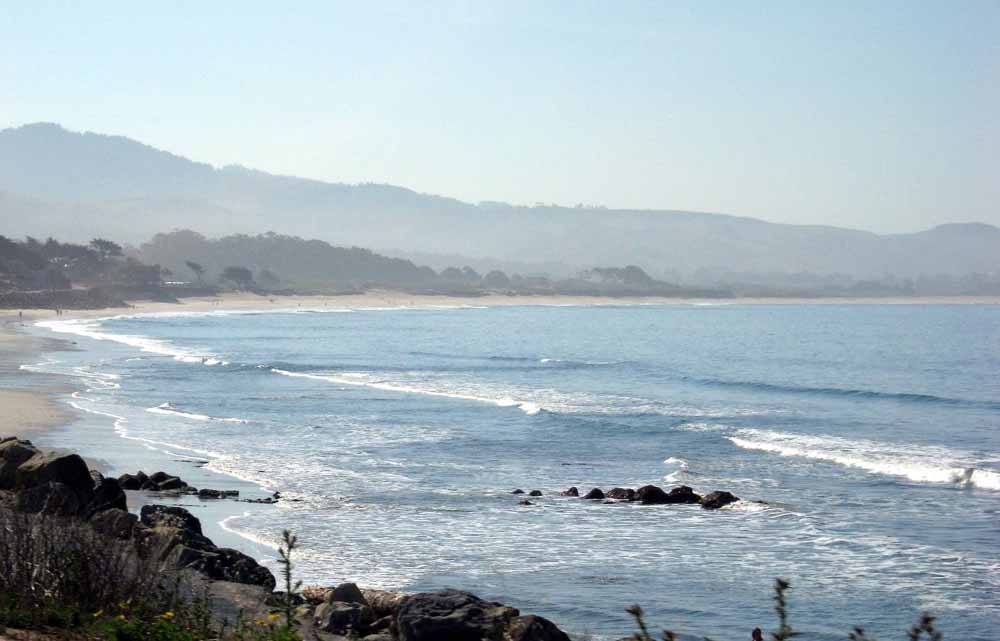
Come on. Just think about it. Walk. Walk slowly with another. Never stop walking. Never come to the end of the beach. Never want to stop walking.
Cove at Half Mooon Bay
This is a nice view of the cove south of the harbor. Not only is it easy to get to, a great walk and very pretty, but also just behind me is a real nice looking restraunt. Unfortunately it wasn't open for breakfast so we fueled up at a coffee shop in town.
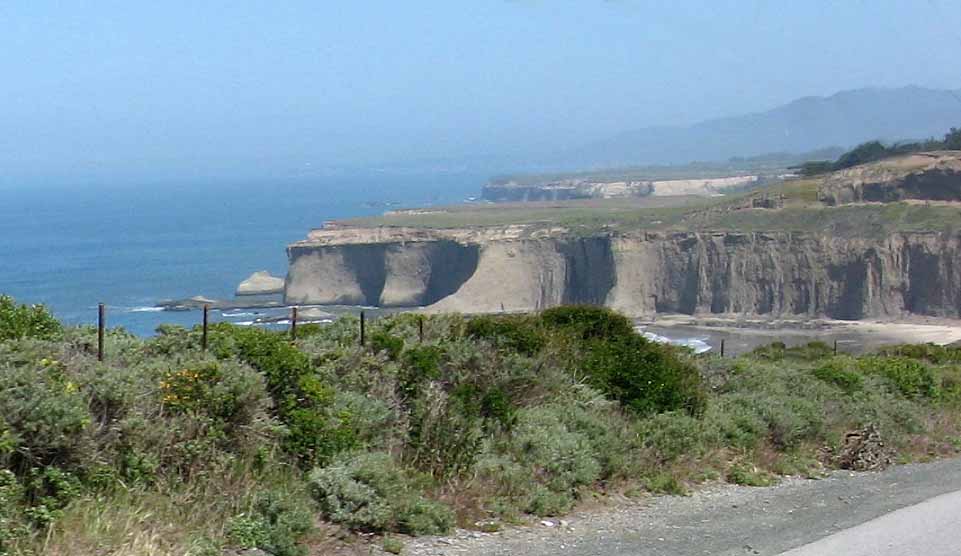
Cliffs
This is the greatest place in the world for practicing giant stride entries. It also illustrates another charming "fact of life" of diving up here. While I cannot overstate the danger of currents taking you off shore, you can probably figure out what to do. Drop your weights and access what you have and where you are. Pick the right direction and swim for your life. You get nearer to shore and out of the current a couple hundred yards later. Rips are dicey as you get near the shore of the cove. Never stop swimming. Currents sometimes sweep in one side of a cove, along its beach and out the other side of the cove. As you approach shore, power across the last 50 feet of long shore current. Better still try to let a wave carry you in some. If the current wants to take you the wrong place, relax. Grab kelp or something. The current will change with the next wave. Don't avoid rocks. Rocks can protect you from the current. Above all relax. Always relax. You may be too tired for a second try.
Oh yah. I said this picture illustrates something. Well, what if after your adventure in Central Coast Currents you found yourself in a cove. You're safe from the sea, but in a cove enclosed within impassible cliffs.
Dive safe and often.
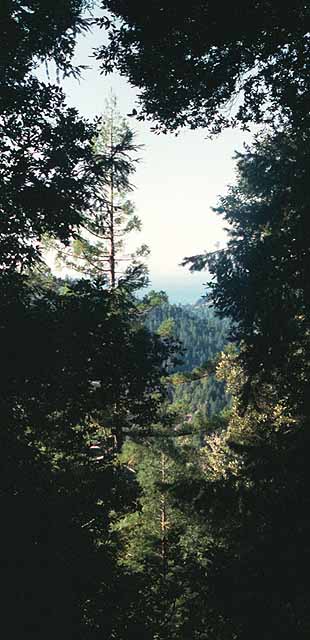
|
In a forest green and primieval, I walked in dappled light among the arboreal gentry.
So cool. So mysterious. The forest blankets steep slopes in soft green. Valleys
cut from summit to shore. This is different world. It should be travelled in
quiet following the natural trails offered to those that have come to visit. Like the shore,
here too you can find beauty, inspiration, adventure and peace. Perhaps you can even find yourself.
|
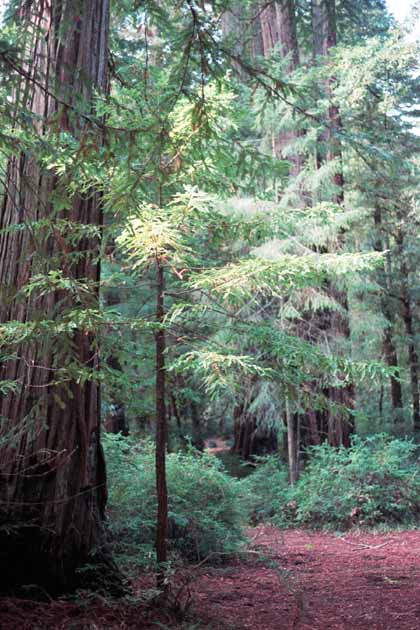
|

Pompanio Beach Panorama
Pompanio Beach is just one of many parks along the route with convenient parking and a
beautiful beach. On a nice day, this area can become quite busy. The entire area north of
this is parking and a nice grassy area for picnicking and bar-b-queing
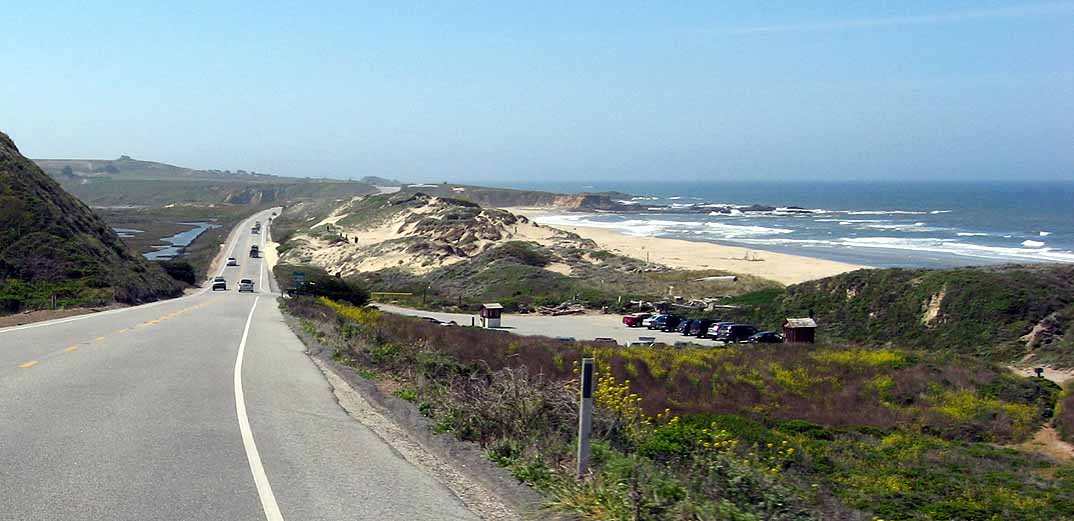
Pescadero State Beach
Over and over you come to beaches just off the road. Each is mostly lightly visited. There is
no trash on the beach other than an occasional redwood tree disposed of by a winter storm.
It is nature that owns the beach and forest.
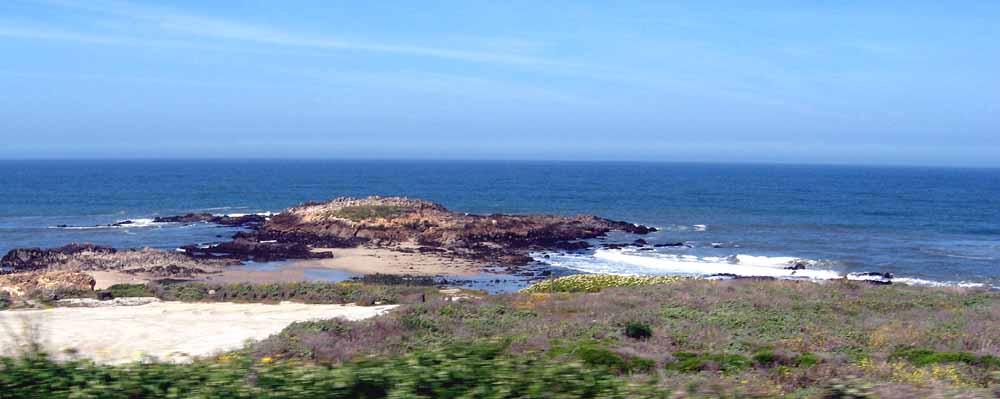
Much of the way, the rocky shore is right off the road. You can endlessly explore places you
have never been.

Could you imagine this in a storm?
It would be right there in front of you! Waves would be rising a mile from shore, moving side to
side as they feel the reef below. They break over and over as they move in shallower and shallower.
Then one last time they make a final effort to throw themselves on the shore at your feet before
falling back.
The ocean may be repelled, but it is never beaten. The waves are endless. The power is there even on
a calm day.
Tidepool Diving
This shore also lends itself to a another completely different kind of diving than most people do.
It is Tidepool Diving. While tide pooling at low minus tides is well enough known, at any low
tide when it's not too rough, you can dive the area between the shore and the outer
reef where most of the waves are really breaking. The waves continue in, but with most of
their energy already dissipated. They break and tip when they find a shallow area of rock, but
they are a shallow effect. You can make your dive under them. There are always
channels and holes that can be traversed under the splash above. It is so shallow that everything
is brilliantly lit by the sun. It is like diving in an aquarium and everything is so close
that you see with crystal clarity even if the visibility is bad. It is exotic diving.
At the edges of the cove the
rocks extend well above the sand. Divers tend to avoid rocks, but if you are in trouble you
can wedge yourself between rocks and relax as waves crash just above. If a big wave set has
come in and all the water is flowing out of a cove, you
head for the side of a cove where the shallow rocks break currents that are heading off shore.
You pull yourself along as shallow as you can get, bouncing over rocks
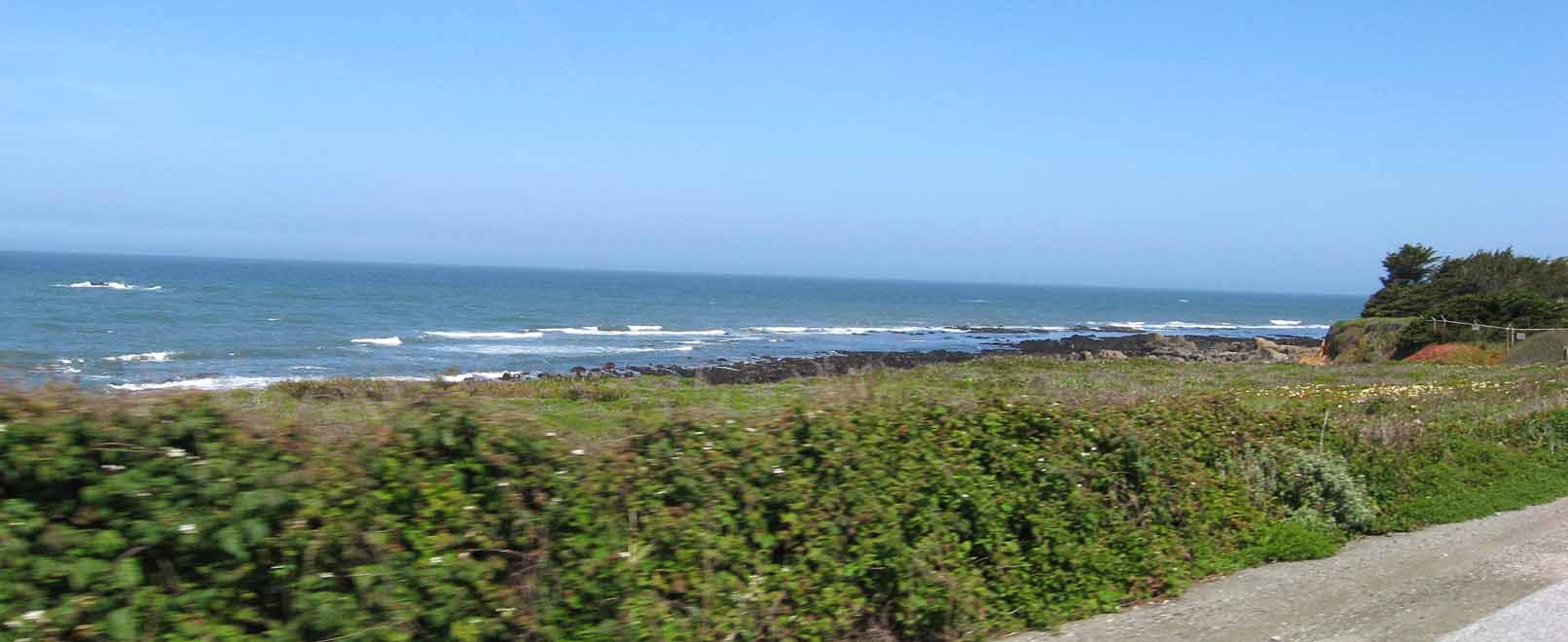
This is endless diving. Not necessarily the greatest diving, but miles
and miles of
shallow rocky reef in an area harsh enough to protect itself from being spoiled.

Coves
Anywhere else the geology would be different and it would be a diver's playground with
easily accessible beaches and coves with rocky reefs that go on forever. It's not though. It's
not the white sharks or the cold or even the waves that do occasionally calm down as the picture
proves. It is that 4 foot visibility, on a good day, that just makes it a questionable dive.

One more cove of soft white sand. There are warm soft breezes in Summer and
cool misty
breezes of Winter. There are the fragrant breezes of Spring and the crisp breezes of Fall.
All make for great company during a walk on the shore.

Pigeon Point Lighthouse From North
This picture didn't stitch too perfectly, but it shows an amazing structure.
Pigeon Point Lighthouse is the second tallest light house on the west coast of America.
It's interesting in itself and it is now a hostel. Notice though. Offshore inside
of those rocks is a large area of excellent diving. It is just like a large
swimming hole surrounded by rocks. There are fish and invertebrates.
Visibility in that area is fairly good for this coast. On a good day it is 6 to 8 feet
or so. The entry is easy
even with a tank. Now being on the north side of that point where the coast makes a
huge turn, this area is about the most exposed piece of real estate on the California
shoreline. The energy of waves coming in here even on a small day can be disconcerting.
I used to go here when I wanted to use scuba instead of freediving for
abalone. There were some abalone here, but not so many and not so large.
It's a great place for walking. The service road to the light houe
extends parellel to Hiway 1 for about a mile. People used to park here all year long in
campers. It was a nice place to retire, but the CHP put an end to it.
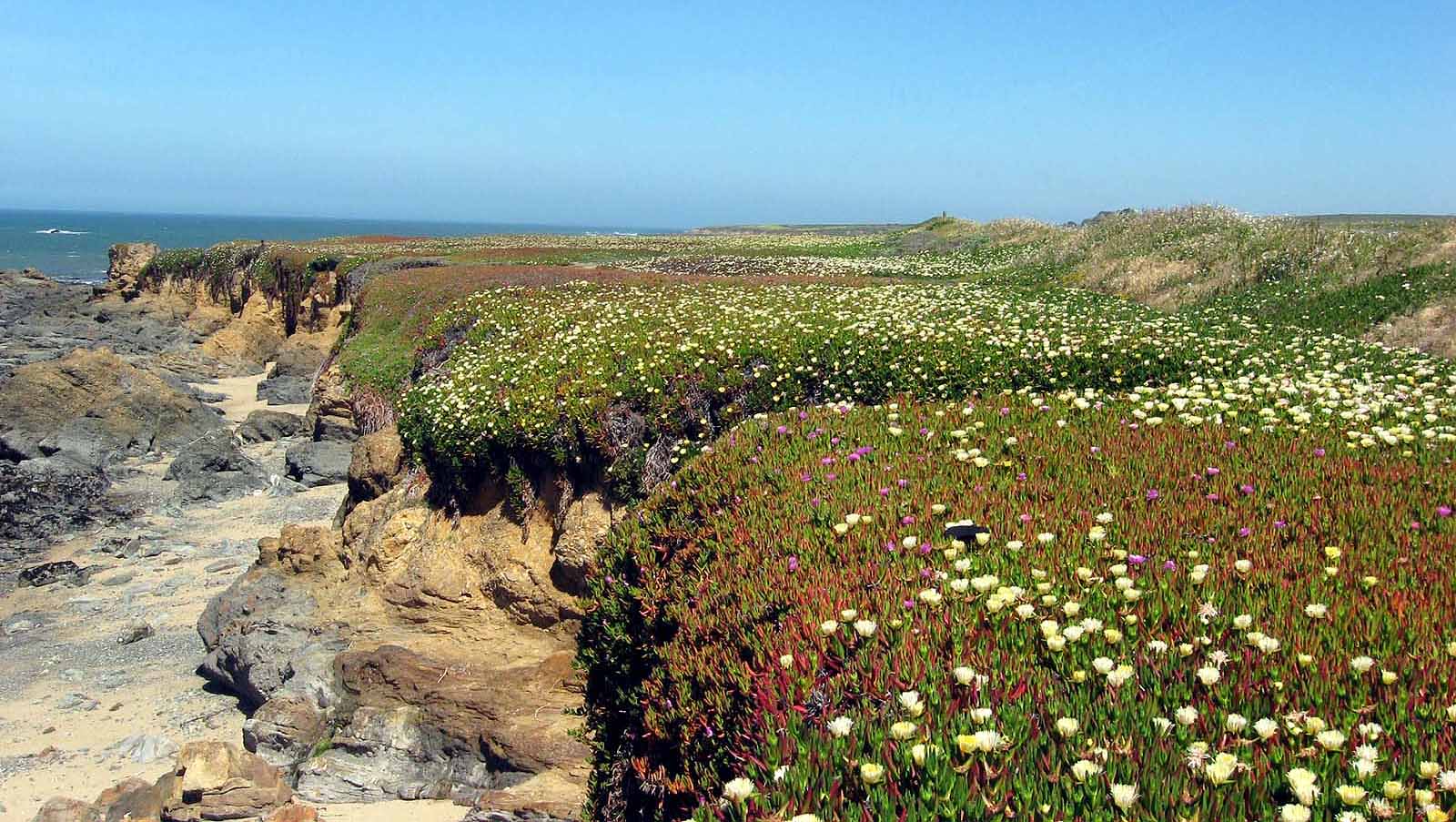
Hardy Pigeon Point Ice Plant Looking North
This is where ice plant grows naturally. The shore. It thrives on the
edge of windy cliffs.
It grows lush in the harsh sea breeze and produces fields made of shimmering color patches of gold,
reds, white and pink pastels. It also makes a fair wind gauge if you are considering diving, but
are not sure if it would be safe in the present wind conditions. You take a heavy branch of ice
plant the size of your hand and throw it down the cliff. If it goes down, diving should be good.
If it flys up and hits you in the face, it's at most a maybe. Go if you really want to dive.
If it flys up over your head, forget it. You're dreaming.
I'm going to put in a few pictures to try to capture Pidgeon Point. One picture just
won't do.
Pigeon Point is where the Clipper Ship Carrier Pigeon ran aground in 1853. I first saw it
when I went there at low tide with intertidal biology classes. I was captivated. It was so primeval
and empty. It was so lush and vital. Here the sea mists formed like ghosts over thick beds of damp
kelps piled on the beach by storm waves. Tidepools were full of strange plants and animals and some
things the nature of which wasn't so obvious.
I came back to dive and explore. The shore is easy to reach for a mile or so south from
the cove below the the
lighthouse. There was more reef than anyone could hope to explore, but I gave it a good try.
I saw this place calm and glassy, but I was not deceived. Yah, it was a good day, but the vis
was still only 6 feet. I saw it when big waves broke on the third reef out about 100 yards.
Then I went back to Santa Cruz to body surf. I saw it when wind howled in on a sunny day and
I just sat in my van reading a book, looking up occasionally to absorb some of the energy.
I saw it on days when the water was calm and looked OK all the way down to the last 3 feet
where it went brown and then black. Careful, you can hit rocks hard. Those days I walked the
shore looking at the flotsam.
On other days I would cross the first shelf of rock and quickly swim past where I thought
there would be waves. I would look at my fins. If I could see them it was going to be a
good day. Then I would swim down, usually no more than 10 feet (much deeper than that and
you may meet someone in a grey suit). You swim between rocks and look in the cracks under
boulders. There were abalone. Not so many and not so large, but plenty for me. I was in no
hurry. I could swim there for hours, too shallow to get cold. I would make a big loop and
only take the biggest abs I found on the way. I knew areas where it was easy to find them
and areas that had other life, but just no abs. There was a hole in the reef like a giant
pool with the top at 8 feet and the bottom at 18. I could spend all day swimming in that
area. I did spend all day swimming in that area. If you could have seen much past your
hand there would have been less to explore, but there was always more to see because it
was so hard to see much at a time.

Pigeon Point Panorama - This is the way I like to see it.
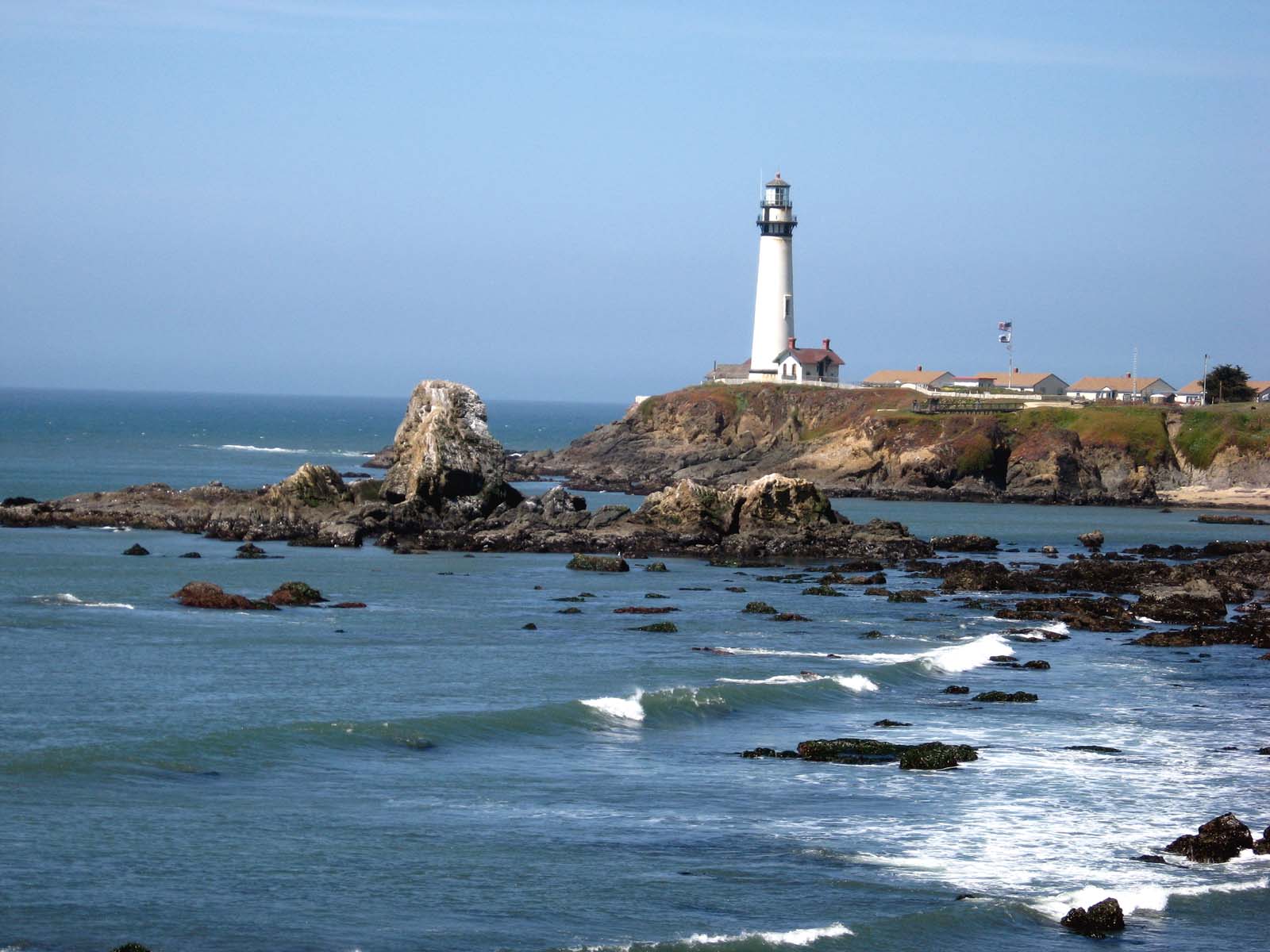
Pigeon Point from the South. Yes, hiking across
that at low tide is amazing. You are leaving the world that is land.
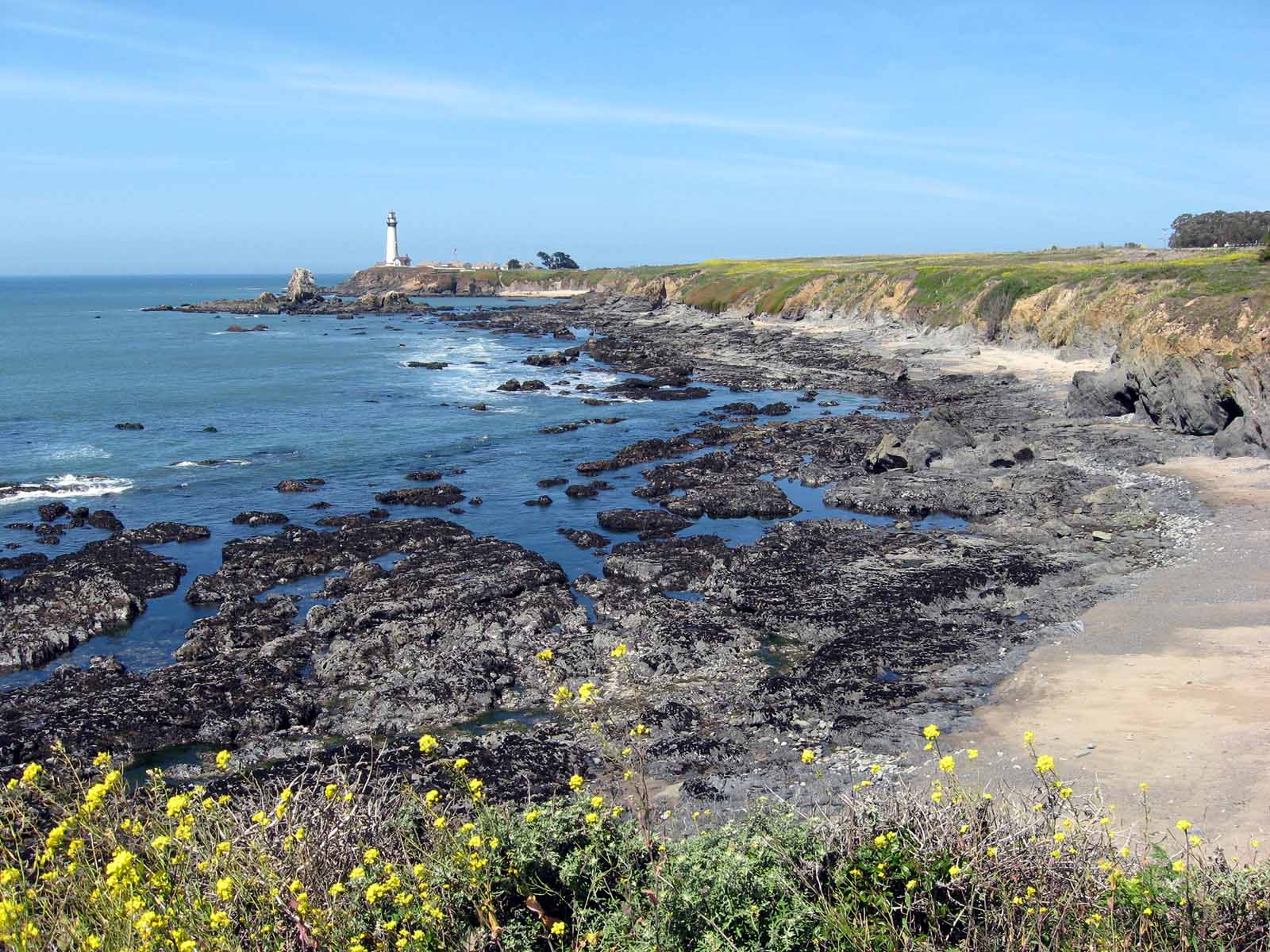
Pigeon Point From South - Pick up your Rock Entery patch on your way out.
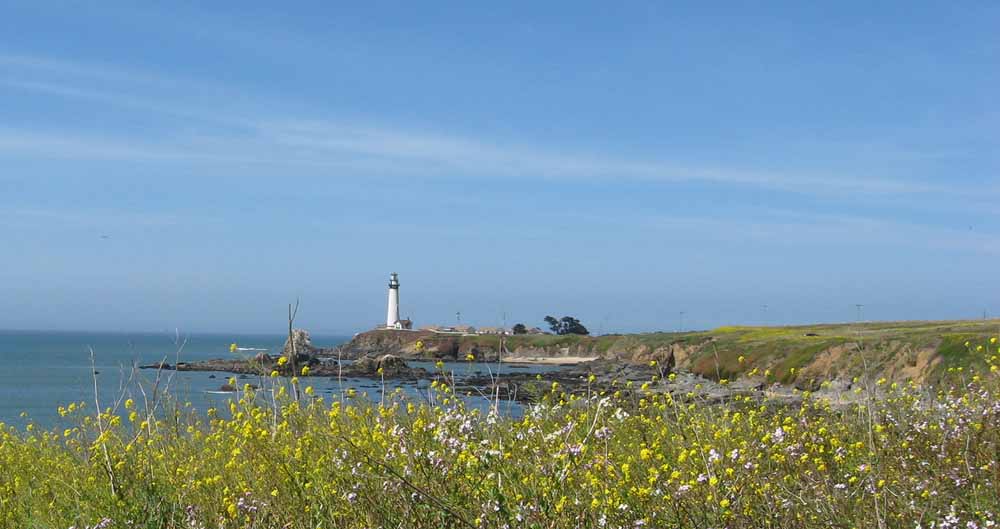
Pigeon Point From South - Flower postcard.

Here's a more natural look. It makes the rock entries really
interesting. This is a day to pass on, but in good weather it is an endless maze of rock
and sea life to explore.
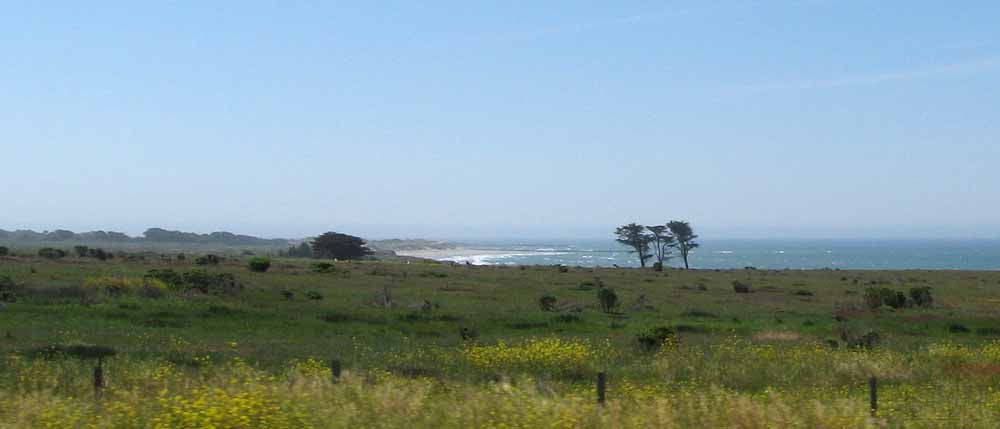
Cypress trees above cove
Ano Neuvo Point sticks out into the Pacific Ocean. The ocean may not conquor the land,
but it sends its winds to sweep away anything not strong enough to endure. Cypress trees resist
the wind by bending with it.
Sometimes you will see a few horses out here in the grass... with their backs to the wind.

Looking North Towards Ano Neavo Island. The cliffs along the
road here constantly crumble without any help from waves.
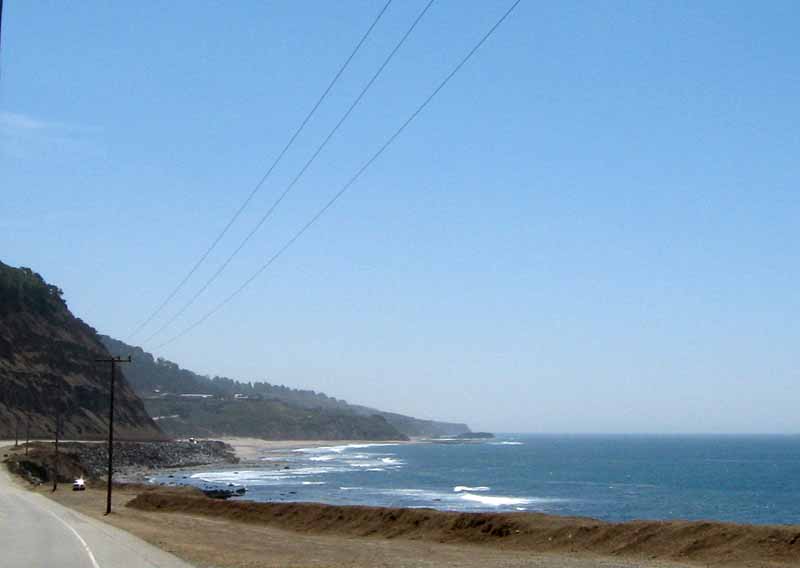
Looking down shore towards Greyhound Rock
This hiway really does just mostly go along the shore.
|
Greyhound Rock... What can I say? Somebody told me that there were abalone there. I was 18. I
was pretty completely nuts ... about diving. Somehow I talked somebody with a car into a ride.
The walk down that cliff will make your butt muscles hurt. Then you have to walk back up it
with your weights and game. You see, there were huge red abalone out there including 9 and
a few 10 inchers. Why not? Visibility was usually only a few feet so encounters with fish were
usually of the quick and close kind in a crack under a rock. You never knew when you would
suddenly come across a crab, a large starfish or a colorful anemone. It was a challenging dive spot.
I would swim from shore to the reef a little past the rock out there on the right. Mostly I
snorkeled for abs, but a few times I took tanks down the cliff too. Looking back now, it's
hard to believe it.
I went there many times. I saw so many moods. The beach would come. The beach would go. Castles
of driftwood were built on the beach by nature and man. I never saw more than a few people
there at a time. It
is beautiful, but it is a little remote and difficult to get to.
My conclusion after a few years of diving there was that it was the most dangerous dive spot I knew
of in California. It wasn't the vicious steep shore break that was like Monastery Beach in
Monterey. It wasn't that the big waves broke out on the rocks at the mouth of the cove where
you were diving. It wasn't the elephant seals that would buzz you or the great white sharks
in the area. The problem was that if you looked a little past the dive area there's something
funny. I'd look and look, but I wasn't sure. After some time watching things I could tell that
there was a current out there just a bit that was deflected out by the rock sticking out from
shore.
Sometimes that current was fast and it was headed into Monterey Bay. After a few years I moved
my diving to Pigeon Point.
Whale bone at Ano Neuvo State Park entrance.
|

|

Greyhound - Good Panorama. Uh... notice those shiney green leaves
in groups of three there on the right side of the picture. There isn't a lot of poison oak
there, but keep your eyes open for it or you may have a problem.
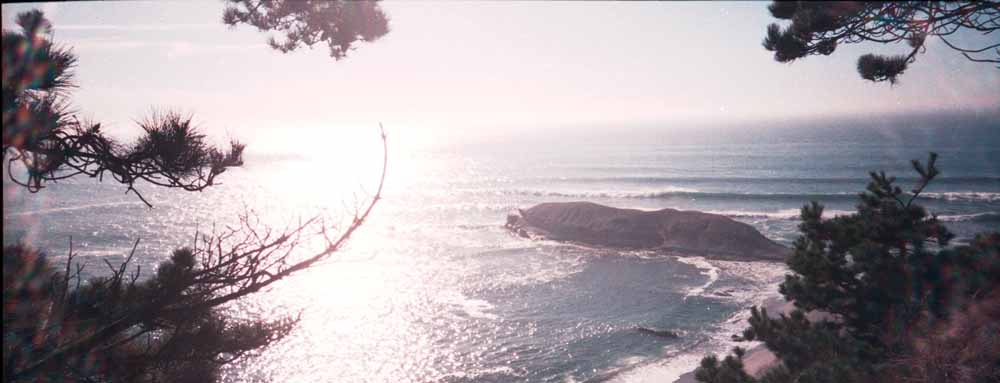
Greyhound Rock - This is a more typical day.
A lazy swell out of the north. Want to go for a swim?
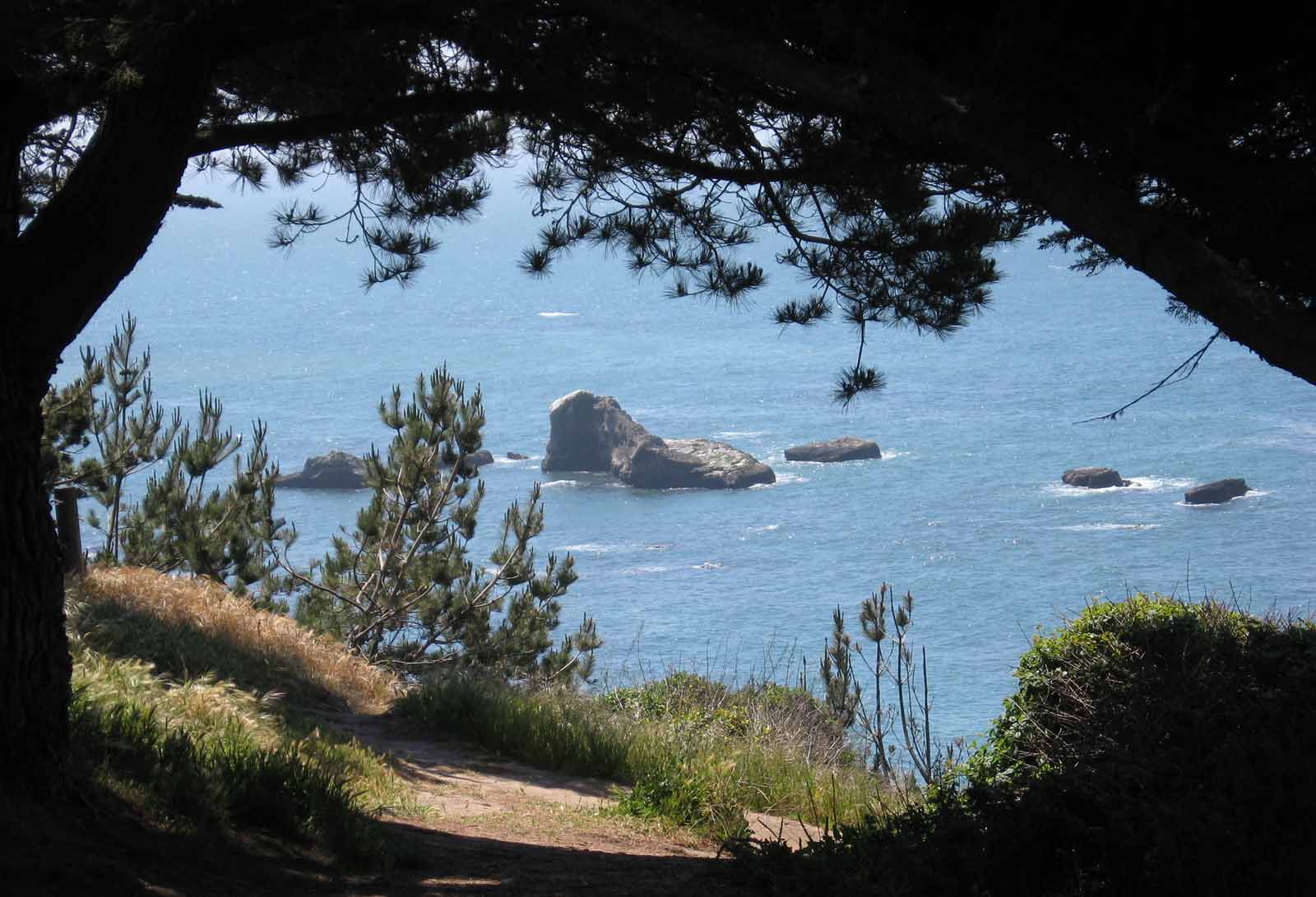
Greyhound Rock - Through The Trees. That is all divable reef.
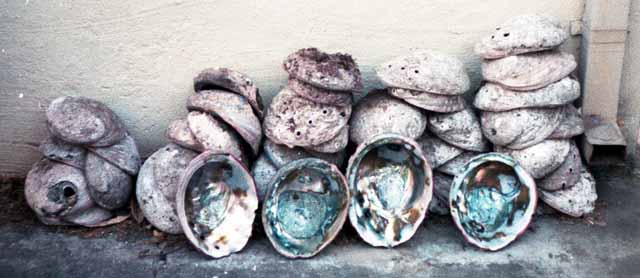
The debris from diving.
Free diving for abalone is always fun.
Free diving compared to scuba diving is like walking through a forest compared to
bicycling through it. You see more. You have a short time. Your concentration must
be completely on what you are
doing and you have to move with both speed and yet with deliberation. Your senses focus because of
the hunt and the physical challenges of the water. The cold is ignored. The push and pull
of the water is all you feel. What is coming from the horizon is all that matters. Then,
you are below the waves in the realm of the fish and seaweed. You are a predator moving
in and of the rocks looking for your prey in dim nooks. You move precisely to take it and
then turn to the surface. You must be ready for whatever is there.

Artichoke Field
The cool weather and the rain from Pacific storms rising on the steep mountains of
the penninsula has always made this a prize agricultural area with fields of strawberries,
artichokes, brussel sprouts and other vegetables that like mild weather and rich dark soil.
There are still railroad tracks that go a little past Davenport.
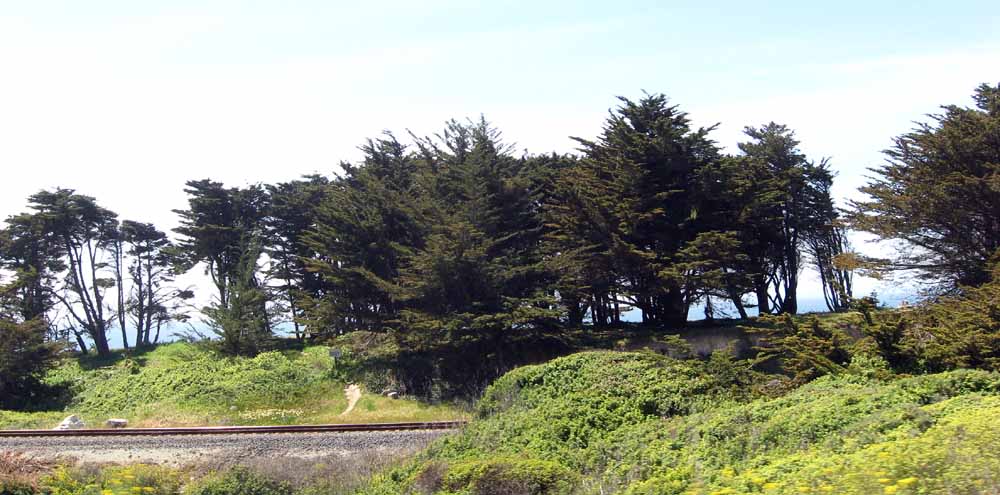
Cypresses Above Cliff across the hiway from the town of Davenport.
I think Davenport was actually a whaling town at one time, but now it has a huge cement plant and
as well as services for day travelers. At the store, you can get any munchie you desire or
necessary provision for a beach party. That row of cypresses is beautiful. A couple feet beyond them
is a cliff. The view is incredible, but people have fallen.
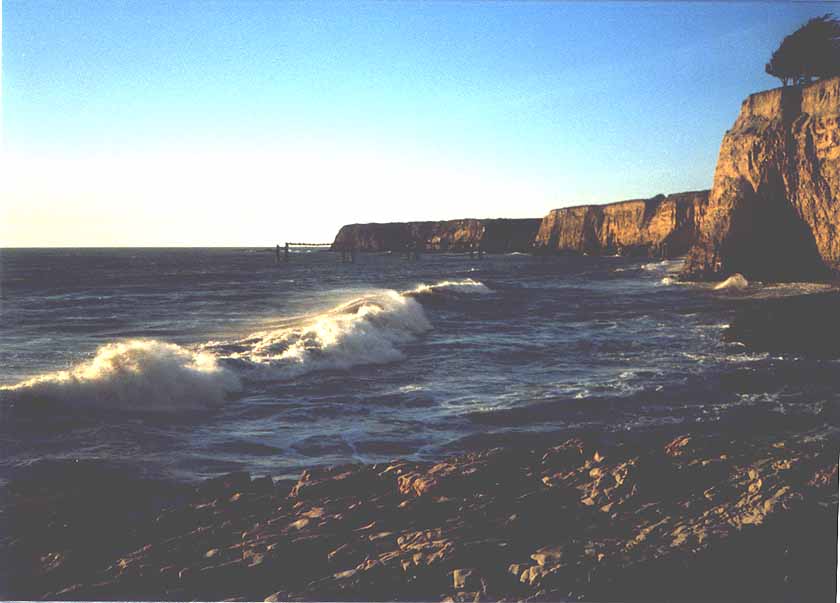
So many years ago my friends and I followed a small steep trail down to a shelf
above the water. It was a pocket protected from the wind. We
cooked 6 or 7 kinds of seafood over a fire in a rock ring... A soaked rock ring. Soaked rocks
that wanted to explode when heated by a fire. It wasn't bad, but it was annoying. The fact that
we were in one of the most scenic places you could want to be, more than made up for some flying
rocks. The food was great, the company was even better.
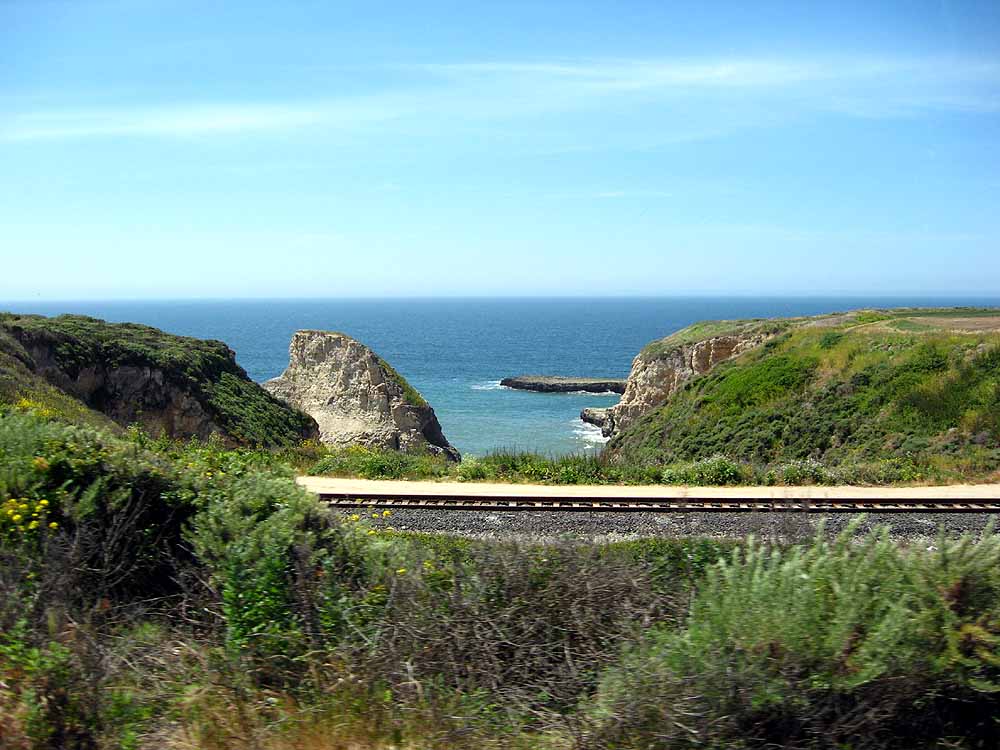
Over Railroad Tracks To Water - First Sight
This doesn't look like much, but coming from Santa Cruz it is the first place I would
see the water. Here I would know what the ocean was offering me that day. Was it going
to be friendly or just how big were the waves going to be?

Bonnydoon Beach Parking
Where a mountain canyon reaches the shore the flood of winter streams carves a cove dropping
between the shoreline cliffs. Most can only be reached by parking along the hiway and hiking
a trail over the railroad tracks and down to the back of the cove. On a good day you can dive
these coves, but on a good day they still aim due south for something like 7000 miles and so
there tends to be waves and currents. Frankly they tend to be better for surfing and there are
always an intrepid few that will carry their board to the furthest point where there is wave
after uncrowded wave.
What these coves are best for though is walking a lonely windy shore. Even on the nicest day
there will be coves beyond the beaten path where you can walk and smell the salt air and feel
the mist and drift into the Sea Dream. If one beach isn't enough, there are many. There is 4
Mile Beach, 4 miles our of Santa Cruz and Red White and Blue beach below the mailbox pointed
those colors. There are many more. You just have to get past the brush to them.
While I liked the beaches for their solitude and natural beauty. Others come for every reason.
Lovers walk along the deserted beach and lay on blankets in the sand, staring into each other's
eyes. Children chase sea gulls along the water. Picnick baskets are placed next to towels as
the beach goers walk the shore. Elders come here to enjoy the beauty of the
wind in the grasses with the time they now have.
Further out though, at the end of Bonny Doon Road, is about the largest area. This is a
huge cove. This is about 12 miles from town. This is a wild place and gets wilder at night.
People build huge pyres of wooden pallets and trees that litter the shore. Flames dance.
People dance. This is the natural environment of the hippie. There are a few still left above
in the hills from long ago. Many keg and bottle has been carried to that cove. Other things
too. It is too remote and vast to be policed much. The spirits of the Merry Pranksters come
here to play on the beach and be crazy. Listen in the fog and you can still hear Neal
Cassady speaking the staccato thoughts only he knows the meaning of.
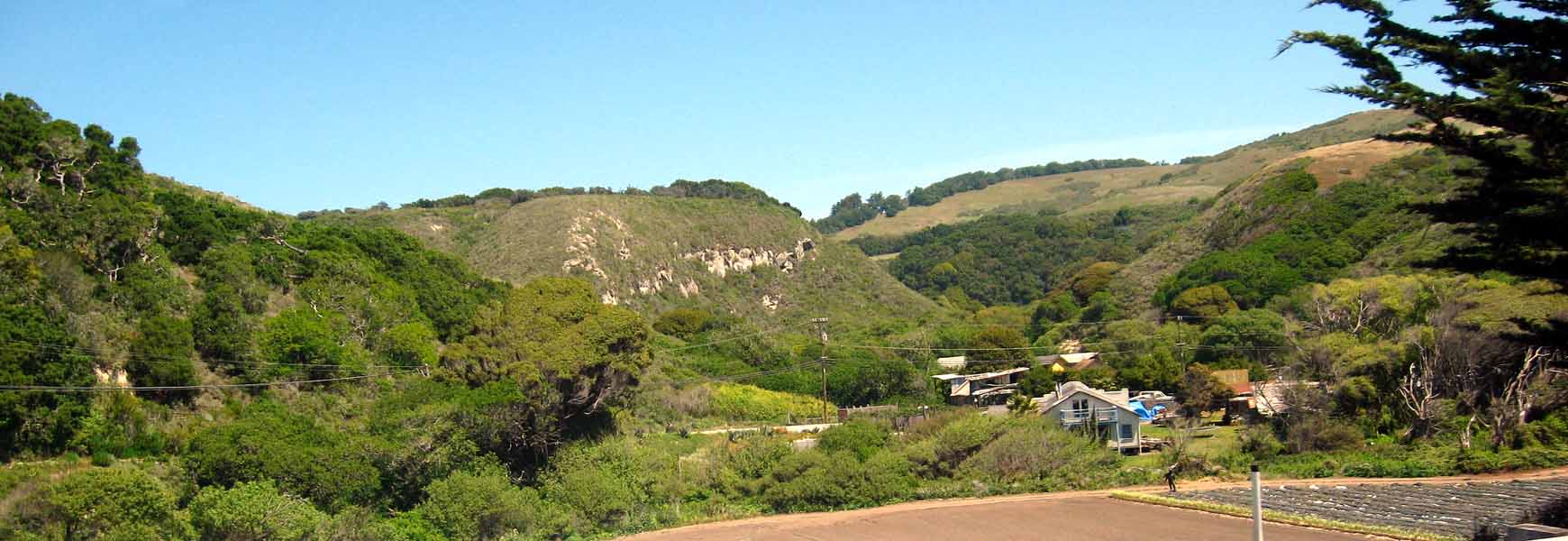
Canyon Into Mountains
Deep shaded canyons go into primeval mountains beneath tall unlogged trees perched on the
ledges of the canyon walls. Here it is silent and still. The leaf litter of the forest sits in
deep piles under trees that have never felt a wind. A small cool clear stream flows along a
sandy bed. Here is the realm of the Amanita Mushroom and the Foot long orange Santa Cruz
Salamander. If there are redwoods, you may encounter the Mighty Yellow Banana Slug, the mascot
of nearby university of California at Santa Cruz. Small birds flit between trees above deer
trails that go straight up. Don't you fall down a canyon wall. It's a long way to go.
If that just isn't enough, there are holes in that canyon wall. There are caves. Late one night
three excited buddies pounded on my door telling about this gaping chasm deep in a cave. They
wanted to go back with my dive lights. My lights weren't going without me. We went through
the night forest down a canyon wall and about 200 feet up the other side, in a rock wall,
was a man sized hole
under words scratched in the rocks proclaiming that "This is the Entrance to Hell". It took us
three hours using ropes to go in about 300 feet. The gaping chasm was about 15 feet deep and
beyond the reach of their little flash lights. It is not a time to think about earthquakes, but
I did. Getting out was a thrill too.
I better leave it here. In these mountains is Big Basin Redwood park and so many forests to
explore it would take another book to describe. If you are adventurous you can enter the forest
from any remote mountain hiway. You will most likely never meet another soul. You can bicycle
along fire roads through groves and meadows that no car is allowed to travel. If you are
closer to the university or above a town, you may meet a troll that lives in these mountains
and they may show you their forest paths and the treasures of these mountains like old lime
mills, fern covered quarries and long abandoned lumber mills.
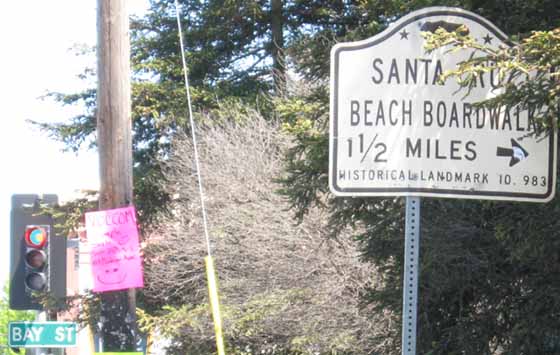
Santa Cruz Sign. Turn right for more beautiful shoreline...
Soon the fields get bigger and go further from the coastal cliffs. You come into Santa Cruz.
Santa Cruz was a quiet old town where people went to the wharf to escape the heat of San Jose
and enjoy the Beach Boardwalk with its rides, games and even a large traditional white
washed wooden Cyclone Racer rollercoaster. The college was built there and revitalized the
town. It changed it too. There is a very eclectic Spring fair each year and the Pacific
Garden Mall held restaurants, music clubs, book stores and everything a tourist or college
student could want. It was sort of Berkeley junior. So much was swept away in the Loma Prieta
earthquake. The town did recover from the extensive damage, but it was far from it was when
Neil Young or the Doobie Brothers would open their tours at the Catalyst Bar. Things like
that are effected by time even more than by tremors in the earth.
Instead of going into town, you can turn on Bay St and head for West Cliff Drive. I always did.
West Cliff Drive goes from
the Boardwalk and pier along the shore to Natural Bridges State Beach. The windy road is
a natural raceway for bicycles and there is a foot / bike path along the length. It is a
wonderful stroll.
Almost every cove you pass has at least a good spot for a a few surfers and the break has been
named by the locals. As for the diving, lets just say it is good if you don't mind some poor
vis and you aren't choosey about ... well... anything.
One night at the shore in a storm with a friend, waves breaking far offshore so big
that we could see their white manes in the dark as they thundered towards shore in herds.
There was a magic that night. Perhaps more than one kind. I remember it for freedom. I
remember love. I remember an intensity of life to match the intensity of the weather.
I don't think I was the same after that night.
The surfing is what it is all about though. They may have lost the lawsuit, but this is
still Surf City. All winter long and a lot of the warm season, big waves come in here
from very far away in the big ocean. They are especially big around the corner from the pier at the
area called Steamer Lane. On a moderate day, there are waves enough for all comers. On
big days there is white spray about a mile out where the waves rise and toss on a reef
in 40 feet of water. The moving mountains called waves start to rise a quarter mile
off shore as they move over the rocky reefs into Middle Peak. The waves of the point
roll over Seal Rock and rise far to high and rough for the skateboard boys on their
short boards to be able to chop through. Ride a wave on a day like that and you will feel
energies that you are just a small splash in.
Steamer Lane was another of my favorite playgrounds for many years, but that and others are
stories for another place and day.
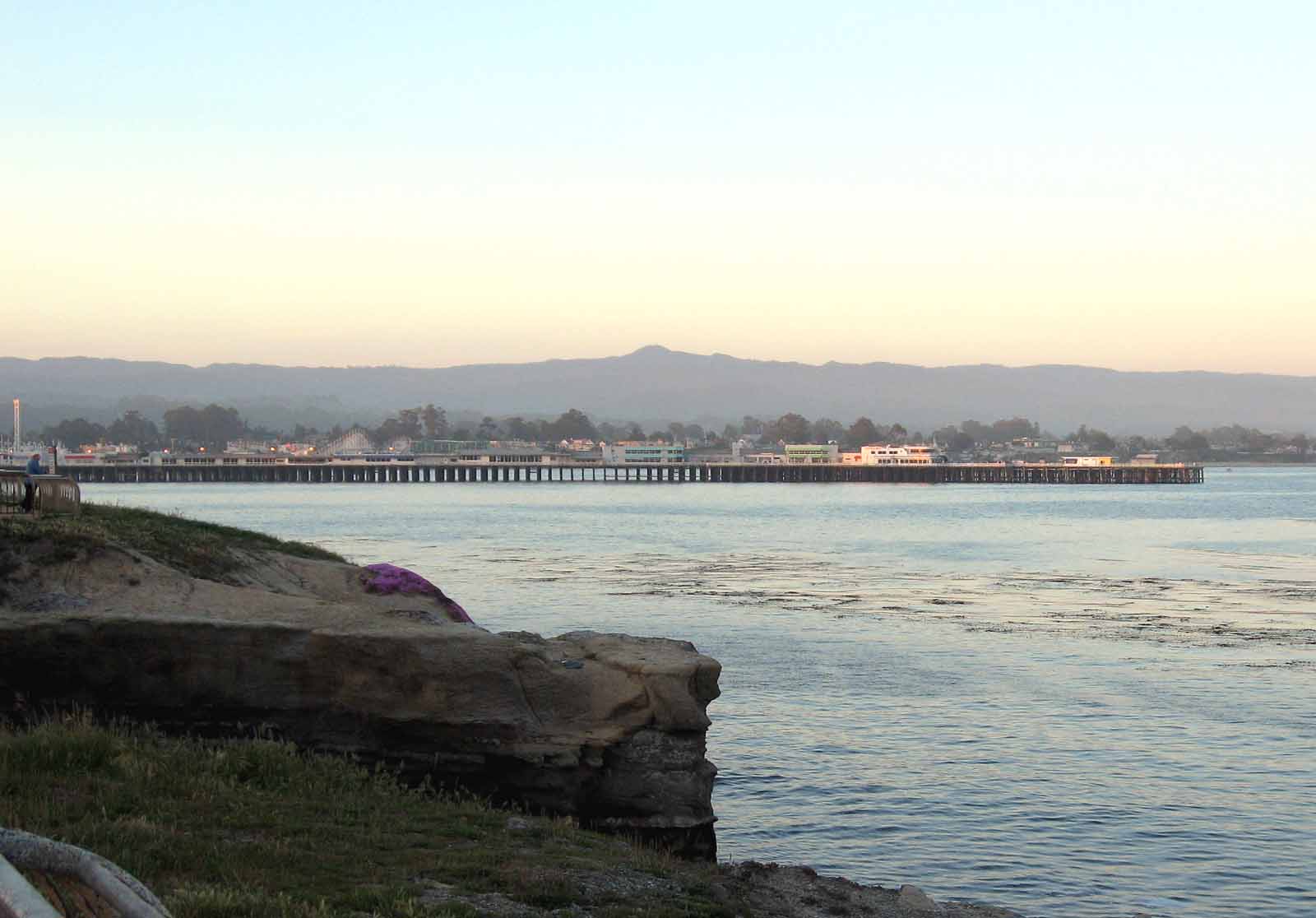
You cannot imagine how many times I walked the length of that wharf,
sometimes alone with my thoughts,
sometimes with friends, sometimes in sun, sometimes in storm and sometimes in the sea dream as gulls wheel above and the barking of the sea lions on the pilings drifts up from below. It is in the gray fog though that we dimly see revealed the faint outlines of those who we would speak with again if we but could.
There is nothing like an old time wharf next to a real beach amusement park. The
takeoff on that wooden Cyclone Racer has a real surprise. There are a number of
good restaurants for very relaxed dining over a beautiful seascape. Go out on a
balcony. Let the ocean breezes caress you.
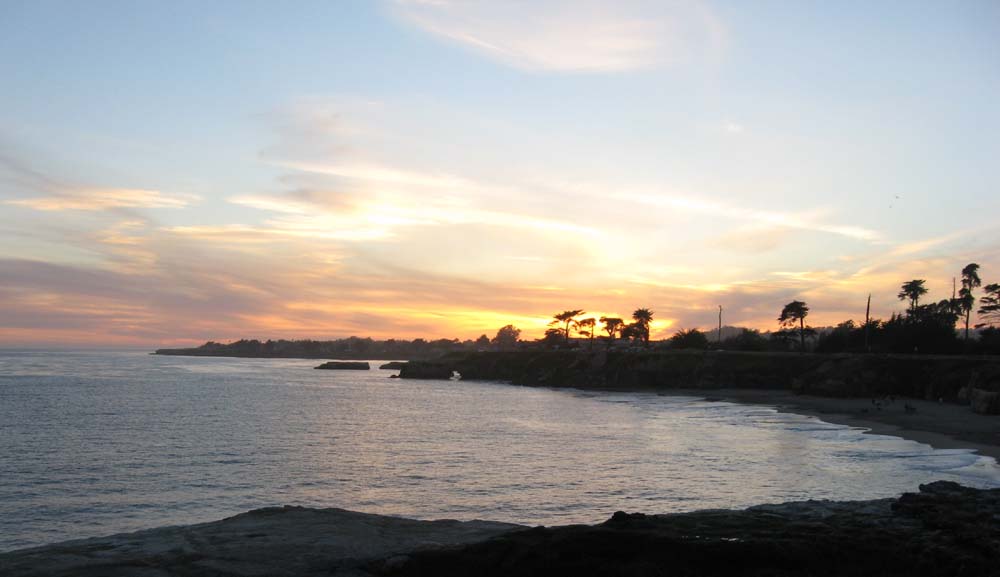
And the day ends over West Cliff Drive as it should, in a splash of warm color to hold
back the dark until the stars light the night.
Back To Start







































